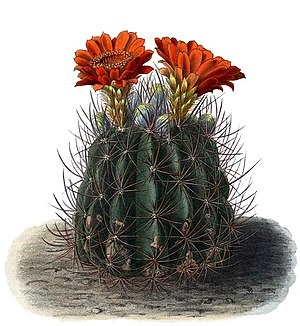Echinopsis lateritia
| Echinopsis lateritia | ||||||||||||
|---|---|---|---|---|---|---|---|---|---|---|---|---|

Echinopsis lateritia |
||||||||||||
| Systematics | ||||||||||||
|
||||||||||||
| Scientific name | ||||||||||||
| Echinopsis lateritia | ||||||||||||
| Pickle |
Echinopsis lateritia is a species of the genus Echinopsis in the cactus family(Cactaceae). The specific epithet lateritia comes from Latin , means '(dark) brick red' and refers to the color of the flowers.
description
Echinopsis lateritia always grows individually with spherical to short cylindrical glaucoma- green shoots , which reach heights of up to 60 centimeters with a diameter of 10 to 12 centimeters. There are 18 sharp-edged, straight or slightly spiral-shaped ribs that are notched. The circular yellowish or gray areoles on it are sunk into the notches and are 2 to 3 centimeters apart. The two to three brownish central spines , rarely only a single one, are curved and thickened at their base. They have a length of up to 1.5 centimeters (rarely up to 3 centimeters). The 15 to 17 brownish radial spines are slightly curved towards the shoot and up to 1 centimeter (rarely up to 1.5 centimeters) long.
The funnel-shaped brick-red to carmine-red flowers open during the day. They become 4 to 5 inches long. The spherical, semi-dry fruits tear open.
Distribution, systematics and endangerment
Echinopsis lateritia is distributed in the Bolivian departments of Chuquisaca , Potosí and Tarija in the Puna vegetation at high altitudes of 2800 to 3200 meters.
The first description by Robert Louis August Maximilian Gürke was published in 1907. A nomenclature synonym is Lobivia lateritia (Gürke) Britton & Rose (1922).
The following taxa were included as a synonym in the species: Lobivia carminantha Backeb. (1936), Lobivia pentlandii f. carminantha (Backeb.) Ullmann (1992), Lobivia kupperiana Backeb. (1936), Lobivia lateritia var. Kupperiana (Backeb.) Rausch (1976), Lobivia cintiensis Cardenas (1959), Hymenorebutia cintiensis (Cardenas) F. Ritter (1980), Lobivia lateritia var. Cintiensis (Cardenas) Ullmann (1990), Lobivia kupperiana var. Rubriflora Backeb. (1959, nom. Inval. ICBN article 8.4), Lobivia lateritia var. Rubriflora (Backeb.) Rausch (1987, nom. Inval. ICBN article 8.4), Lobivia scopulina Backeb. (1962, nom. Inval. ICBN -Artikel37.1) Lobivia camataquiensis Cardenas (1963), Lobivia lateritia var. Camataquiensis (Cardenas) Ullmann (1992), Lobivia cintiensis var. Elongata F.Ritter , (1963) Lobivia imporana var. elongata U.Köhler (1966, nom. inval. ICBN -Article 36.1), Lobivia lateritia var. cotagaitensis noise (1977), Hymenorebutia torataensis F.Ritter (1980), Hymenorebutia torreana F.Ritter (1980), Lobivia lateritia var. citriflora noise (1980) and Lobivia imporana F.Ritter (1980, nom. inval. ICBN -Article 34.1).
In the Red List of Threatened Species of the IUCN , the species is listed as " Least Concern (LC) ". H. listed as not endangered.
proof
literature
- Edward F. Anderson : The Great Cactus Lexicon . Eugen Ulmer KG, Stuttgart 2005, ISBN 3-8001-4573-1 , p. 234 .
Individual evidence
- ↑ Urs Eggli, Leonard E. Newton: Etymological Dictionary of Succulent Plant Names . Springer, Berlin / Heidelberg 2010, ISBN 978-3-642-05597-3 , p. 133.
- ↑ M. Gürke: Echinopsis lateritia Gürke: n. Sp. In: Monthly for cactus science . Volume 17, Number 10, 1907, pp. 151-152 ( online ).
- ^ NL Britton , JN Rose : The Cactaceae . Descriptions and Illustrations of Plants of the Cactus Family . tape III . The Carnegie Institution of Washington, Washington 1922, p. 56 ( online ).
- ↑ Echinopsis lateritia in the IUCN Red List of Threatened Species 2013.2. Posted by: Lowry, M., 2010. Retrieved March 1, 2014.